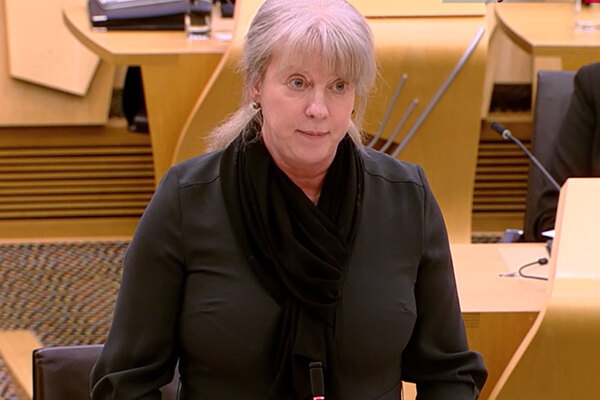How to build at volume and create successful places
An Inside Housing roundtable, in association with law firm Capsticks, looks at the role the sector can play in increasing delivery and building strong communities. Illustration by Neil Webb
In association with:

As crises go, the housing shortage is one of the most persistent. Governments and housing secretaries have come and gone, targets have been set and abandoned, and it remains unsolved.
The current UK government target is for 300,000 new homes a year in England, and the sector is more than keen to play its part – but it faces its own unique set of challenges along the way. So, can it be done? And how best to ensure the work delivers for communities?
At an Inside Housing roundtable, sponsored by Capsticks, a panel of experts came together to try to answer these questions.
The panel starts by discussing the biggest roadblocks to volume delivery. One of the most significant, argues Chimi Shakohoxha, head of housing and regeneration at Capsticks, is the complicated business reality in which the sector operates.
“The majority of housing associations go to the money market to raise finance, with the result that they have to act like PLCs – and on top of that they have to comply with the [housing] regulatory regime,” he says. He suggests that in his experience, even grant-funded developments have problems, with compliance adding up to £11,000 to the cost of each unit. “I’d like to see government scrap or reduce that regime,” he adds.
The government could relieve pressure in other ways, too – such as making land easier and less costly to acquire, says Oliver Boundy, executive director for development and growth at Southern Housing Group. “The limiting of land supply by speculators and house builders is something that the government could step in to control or limit,” he says. “That could be addressed to accelerate the release of land supply for housing.”
The government also needs to work with housing providers to unlock larger sites, argues Nick Wood, director of development at Clarion Housing Group.
“It’s key, in particular with infrastructure delivery, so that when we do deliver these new communities, the right infrastructure is in place to ensure they are successful – and that we don’t develop places where people have to drive 20 minutes to a supermarket,” he says. “That’s not sustainable in the long term.”
Another source of friction that lies within the remit of national and local government is the planning system. Even with land, funding and expertise in place, the process can keep the best-laid schemes in limbo for years.
“We need to take the politics out of planning,” says Guy Slocombe, chief investment officer at Hyde Group. “But I’m not naive enough to think that’s possible.”
“The politics is a problem,” agrees Suzanne Smith, head of planning at Capsticks. Having worked in local authority planning departments, Ms Smith can see this issue from both sides of the fence. “Planning officers have a really difficult job,” she says. “They are under-resourced and there aren’t enough of them. But that’s not enough to explain the often lengthy planning delays. At one local authority, it was a nightmare. Planning officers were constantly backing up against members as they tried to get schemes through.”
Often, recommendations for planning approval would be refused by members who simply did not want new development in their ward.
Needing buy-in
For Amanda Williams, group development director at Aster Group, the real source of this friction is one step beyond elected councillors. “The real reason planning applications fall foul of members is not because of the members themselves, it’s because of the people who vote for them,” she says. “We need to have buy-in from the population of this country for the homes we need.”
The housing crisis is also perpetuated by the fact that its remedy is often fiercely opposed. Getting community buy-in to new development can be a huge challenge.
“The biggest issue is that nobody likes development,” says Jo Curson, assistant director of development at GreenSquareAccord. “The government can make whatever changes it likes to planning policy, but on a local level, very few people embrace development. It always feels like we are pushing uphill.”
In numbers
300k
Government target for new homes per year in England
“People are anti-development,” agrees Andy Fallon, head of land at Sovereign Housing Association. “There’s a scheme near my parents’ house, and when the planning application went in, every man and his dog seemed to go against it. There’s an opportunity there for good quality new housing for people who grew up in the village. Perhaps I was ignorant to just how much anti-development sentiment is out there.”
One way to change minds, Ms William suggests, is by drawing attention to the social and economic benefits that new developments can bring to communities – greater footfall in the local high street, for example.
“Sustainability of a place can follow development, rather than the other way round,” she says. “We need to sell that – and we don’t do that enough as a sector.”
Regeneration is mentioned by many members of the panel as a way to both increase housing numbers and to create more sustainable places – and all without having to fork out on new land. Clearly, though, it is crucial to work out how this will benefit existing communities and involve them in every step of the discussions.
“It’s quite a challenge to get residents on board with the idea that you might be able to redevelop their estate and build more homes there, but as an organisation it’s something we have to think about – especially when land is expensive,” says Jacqueline Esimaje-Heath, regional development director at L&Q.
Getting this right is crucial, and bringing local people on side should benefit everyone.
“We need to be much more honest in our engagement with residents at the start, and enable residents to be involved in the process,” says Anna Kear, chief executive of Tonic Housing. “Residents have a huge amount to contribute – and taking the anger and emotion out of those situations can then make it a beneficial process. They become your champions in the planning process.”
It is clear that having local support behind a scheme can make the planning process much smoother – so how can housing providers give themselves the best chance of garnering that support?
“It’s a long-term game,” says Ms Curson. “You cannot rush these conversations, and every community is different. You have to actively listen to what people are telling you because there is mistrust and concern.”
“If your messaging is right, people can see the benefit of what you are trying to do,” agrees Mr Slocombe.
The architects designing new homes also have a part to play, says Huw Williams, architect and director at London-based practice Fourth Space. “There is a series of questions the profession should ask itself about its role,” he says. “Where does it sit in the [development] process, and what can it do to help resolve key issues around delivery… such as how architecture and new development are seen by existing communities?”
The challenges associated with regeneration are compounded by one obstacle that several on the panel bring up. “It’s not helped by [government] not allowing grant money to be used for regeneration,” says Ms Esimaje-Heath. “It frustrates the process – and there’s an opportunity there that we can’t tap into at this time.”
Reversing this rule would make sense, argues Mr Shakohoxha. “The government removing restrictions on grant funding on regeneration would kill two birds with one stone,” he says. “It’d help to accelerate progress towards net zero homes by getting rid of older properties that can’t be retrofitted, and it would make it much easier for providers to build new capacity.”
The zero-carbon drive is a “risk to us all”, says Becky Utuka, director of development and sales at Gateway Housing. “All our assets are in danger. Funders are asking, ‘Can we have the data on sustainability?’ Most of us raise money to build more houses based on our assets, and if [the value of] our assets is going to be affected because of this new standard, we are in danger of halting the ship.”
Nick Byrne, executive director of development at Citizen, says meeting the costs of zero carbon will put his organisation’s target of 550 new homes each year in jeopardy. “It is inevitable that if we are going to have to do zero-carbon work with no state aid – and regeneration not being eligible for grant is symptomatic of that – then it’s a pipe dream to build 550 homes a year,” he says. “That’s a massive issue for the sector.”
Teamwork
Given the scale of the barriers to development that the sector is facing, could the government’s overall target itself be a pipe dream? “We have to be realistic,” says Ms Esimaje-Heath. “It’s romantic to think we can get to those levels when we have these challenges facing us.”
As well as finding ways to cope with these external pressures, the sector needs to work together, large and small, if it is to have a chance of building new homes in the numbers we need, argues Heather Thomas, chief executive of Sapphire Independent Housing. “The scale of the housing crisis is such that everybody has to play a part,” she says. “There is a lot of focus on what larger providers and developers are doing; I would argue... that smaller associations and local authorities need to be encouraged to build, too. In the past, the only way we dealt with a housing crisis was by getting everyone involved – and we require a similar effort today.”
Participants
Martin Hilditch (chair)
Editor, Inside Housing
Oliver Boundy
Executive director of development and growth, Southern Housing Group
Nick Byrne
Executive director of development, Citizen
Jo Curson
Assistant director of development, GreenSquareAccord
Jacqueline Esimaje-Heath
Regional development director, L&Q
Andy Fallon
Head of land, Sovereign
Anna Kear
Chief executive, Tonic Housing
Chimi Shakohoxha
Head of housing and regeneration, Capsticks
Guy Slocombe
Chief investment officer, Hyde
Suzanne Smith
Head of planning, Capsticks
Heather Thomas
Chief executive, Sapphire Independent Housing
Becky Utuka
Director of development and sales, Gateway Housing
Amanda Williams
Group development director, Aster Group
Huw Williams
Architect and director, Fourth Space
Nick Wood
Director of development, Clarion













